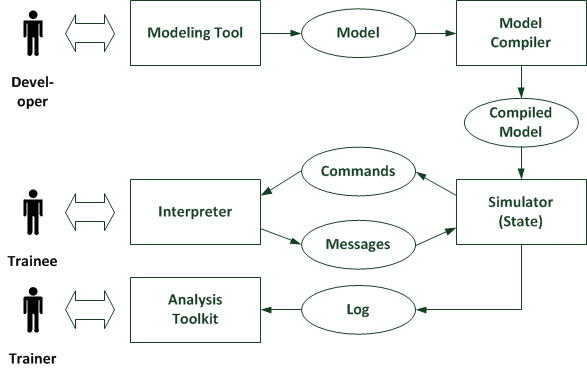The SESAM - System: Difference between revisions
From Ameise-en
Jump to navigationJump to search
m moved The SESAM-system to The SESAM - System |
No edit summary |
||
| (9 intermediate revisions by one other user not shown) | |||
| Line 1: | Line 1: | ||
{{NavigatorBar|The QA- | {{NavigatorBar|The QA - Model|AMEISE}} | ||
===The | ===The Structure of the SESAM - System=== | ||
The main objective | The main objective when using SESAM is to provide an almost realistic simulation environment of software projects for training purposes. On the basis of a simulation run, trainees should be able to apply their acquired knowledge in a game-like environment and strengthen their management skills. | ||
Another | Another objective is to make assumptions about effects of project decisions and study the consequences by replaying them in the simulation environment. The SESAM - System consists of various ''' Components ''' which are used by different roles: | ||
* ''' | * '''Modeler''': | ||
** He creates | ** He or she creates the empirical models that are simulated by the simulation engine. The modeler determines which objects and relationships of a software project are mapped to the system and what effects may occur. He or she defines the world in which the trainee is able to move. | ||
* '''Trainee''': | * '''Trainee''': | ||
** The trainee takes the role of | ** The trainee takes the role of a project manager. By issuing commands he intervenes in the course of a simulation run and receives messages about the current state from the system. | ||
* ''' | * '''Instructor''': | ||
** The tutor conducts training courses | ** The instructor (or tutor) conducts training courses where trainees are able to participate. He or she guides trainees and he has the possibility to analyze simulation runs by several evaluation tools. Finally, he or she also discusses the achieved results together with the trainees. | ||
The following figure shows the ''' | The following figure shows the '''Roles ''' and their '''Interaction ''' with the components of the system. | ||
[[Image: | [[Image:Komponenten_en.gif|center|frame|Components and Roles of the SESAM - System]] | ||
{{NavigatorBar|The QA- | {{NavigatorBar|The QA - Model|AMEISE}} | ||
[[Category:Tutorial]] | [[Category:Tutorial]] | ||
__NOEDITSECTION__ | |||
[[de:Das SESAM-System]] | [[de:Das SESAM-System]] | ||
[[en:The SESAM- | [[en:The SESAM - System]] | ||
<!-- | <!-- | ||
[[sk:Hlavná stránka]] | [[sk:Hlavná stránka]] | ||
[[fr:Accueil]] | [[fr:Accueil]] | ||
--> | --> | ||
Latest revision as of 14:40, 16 May 2013
The Structure of the SESAM - System
The main objective when using SESAM is to provide an almost realistic simulation environment of software projects for training purposes. On the basis of a simulation run, trainees should be able to apply their acquired knowledge in a game-like environment and strengthen their management skills.
Another objective is to make assumptions about effects of project decisions and study the consequences by replaying them in the simulation environment. The SESAM - System consists of various Components which are used by different roles:
- Modeler:
- He or she creates the empirical models that are simulated by the simulation engine. The modeler determines which objects and relationships of a software project are mapped to the system and what effects may occur. He or she defines the world in which the trainee is able to move.
- Trainee:
- The trainee takes the role of a project manager. By issuing commands he intervenes in the course of a simulation run and receives messages about the current state from the system.
- Instructor:
- The instructor (or tutor) conducts training courses where trainees are able to participate. He or she guides trainees and he has the possibility to analyze simulation runs by several evaluation tools. Finally, he or she also discusses the achieved results together with the trainees.
The following figure shows the Roles and their Interaction with the components of the system.
